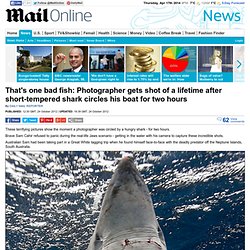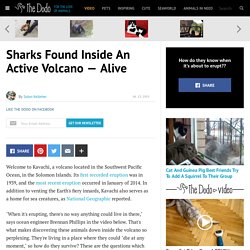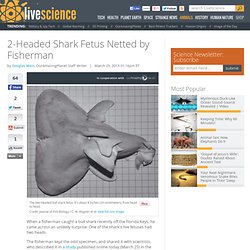

Despite human's fear and distrust of these ancient animals, only 4 people are fatally attacked by sharks each year. Conversely, 100 million sharks are killed by humans annually. That's one bad fish: Real-life Jaws scenario. By Daily Mail Reporter Published: 12:30 GMT, 24 October 2012 | Updated: 18:39 GMT, 24 October 2012 These terrifying pictures show the moment a photographer was circled by a hungry shark - for two hours.

Brave Sam Cahir refused to panic during the real-life Jaws scenario - getting in the water with his camera to capture these incredible shots. Australian Sam had been taking part in a Great White tagging trip when he found himself face-to-face with the deadly predator off the Neptune Islands, South Australia. An Ocean Love Story. Mysterious Sharks Seen For First Time in Australia. Shark biologists have announced the discovery of two sharks never seen before in Australian waters.

Mandarin dogfish, Cirrhigaleus barbifer (OpenCage.info / CC BY-SA 2.5) “The rare sharks were caught off Rottnest Island two years ago at a depth of 1410 feet (430 m) by local recreational fisherman Steve Downs,” explained Dr Ryan Kempster, biologist with the University of Western Australia’s Oceans Institute. Mr Downs gave the sharks to a group of researchers at the Oceans the University of Western Australia. The specimens were a male just under 3.3 feet (1 m) long and a pregnant female about 4 feet (1.2 m) long.
“After two years of thorough investigation which included DNA sequencing, the sharks were identified as mandarin dogfish (Cirrhigaleus barbifer), a species never before seen in Australia,” Dr Kempster said. “This species was known previously to be found only between Indonesia and Japan, and also New Zealand.” It’s not known why the sharks were found so far from their normal habitat. Sharks Found Inside An Active Volcano — Alive. Welcome to Kavachi, a volcano located in the Southwest Pacific Ocean, in the Solomon Islands.

Its first recorded eruption was in 1939, and the most recent eruption occurred in January of 2014. In addition to venting the Earth's fiery innards, Kavachi also serves as a home for sea creatures, as National Geographic reported. "When it's erupting, there's no way anything could live in there," says ocean engineer Brennan Phillips in the video below. That's what makes discovering these animals down inside the volcano so perplexing.
They're living in a place where they could "die at any moment," so how do they survive? Putting Size into Perspective. Shark Threat Display. Prehistoric shark captured on film. White Shark just beneath the surface. School of Rays. A rare megamouth shark just washed up in the Philippines. The recent spate of strange shark sightings just keeps going.

Today, a rubbery-lipped, 15-ft. (4.5 m) beastie washed up on a beach in the Philippines. The creature turned out to be a megamouth shark—a species so rare that Christopher Bird, a marine zoologist and blogger, has estimated it’s only the 60th confirmed human encounter with one. Before 1976, no one had any idea megamouths existed (officially, at least). It was in Hawaii that year that a 14.6-footer gulped down a submerged parachute filled with sand, which a US Navy ship was using as an anchor.
Scientists were as baffled as the crewmen: though loosely related to two other, mostly vegetarian, shark behemoths—the whale shark and the basking shark—the creature belonged to a previously unrecognized family, genus, and species. Its family tree has something to do with its comically gaping maw. The rarity of sightings is one thing that still confounds Bird and other marine scientists. Great White Shark Attack. Shark Attacks Shark in Dramatic Video.
A college student on a fishing trip in the Gulf of Mexico caught dramatic footage of a big tiger shark repeatedly attacking a hammerhead on a fishing line.

Shot on July 17, the video shows a hammerhead shark struggling on the line. Then, a tiger shark cruises in and bites the hammerhead. The attack went on for several minutes, until the tiger shark "grabbed the hammerhead around its head, broke the line, and then dragged him straight down," says Ryan Willsea, who made the video with his brother Aaron, and whose line caught the hammerhead. "It was an incredible thing to see and catch on film," he says. Willsea spent three days fishing in the Gulf during a vacation to the area, using baitfish and hoping to catch tuna. "When we got the hit, we first thought it was a another big tuna," says Willsea, who had caught two other tuna earlier that day. Feeding a Hammerhead. Jersey Shore shark attacks of 1916. The Jersey Shore shark attacks of 1916 were a series of shark attacks along the coast of New Jersey, in the United States, between July 1 and 12, 1916, in which four people were killed and one injured.

The incidents occurred during a deadly summer heat wave and polio epidemic in the United States that drove thousands of people to the seaside resorts of the Jersey Shore. Since 1916, scholars have debated which shark species was responsible and the number of animals involved, with the great white shark and the bull shark most frequently cited. Personal and national reaction to the fatalities involved a wave of panic that led to shark hunts aimed at eradicating the population of "man-eating" sharks and protecting the economies of New Jersey's seaside communities. Resort towns enclosed their public beaches with steel nets to protect swimmers. Scientific knowledge about sharks before 1916 was based on conjecture and speculation. Incidents and victims[edit] Me my Shark and I. John Singleton Copley "Watson and the Shark" (1778) Cyclops Shark & Other Cryptic Creatures. In this world of Photoshop and online scams, it pays to have a hearty dose of skepticism at reports of something strange — including an albino fetal shark with one eye smack in the middle of its nose like a Cyclops.

But the Cyclops shark, sliced from the belly of a pregnant mama dusky shark caught by a commercial fisherman in the Gulf of California earlier this summer, is by all reports the real thing. Shark researchers have examined the preserved creature and found that its single eye is made of functional optical tissue, they said last week. It's unlikely, however, that the malformed creature would have survived outside the womb. "This is extremely rare," shark expert Felipe Galvan Magana of Mexico's Centro Interdisciplinario de Ciencias del Mar told the Pisces Fleet Sportfishing blog in July. "As far as I know, less than 50 examples of an abnormality like this have been recorded. " Basking Shark. Fisherman Finds 2-Headed Bull Shark.
When a fisherman caught a bull shark recently off the Florida Keys, he came across an unlikely surprise: One of the shark's live fetuses had two heads.

The fisherman kept the odd specimen, and shared it with scientists, who described it in a study published online today (March 25) in the Journal of Fish Biology. It's one of the very few examples of a two-headed shark ever recorded — there about six instances in published reports — and the first time this has been seen in a bull shark, said Michael Wagner, a study co-author and researcher at Michigan State University. Technically called "axial bifurcation," the deformity is a result of the embryo beginning to split into two separate organisms, or twins, but doing so incompletely, Wagner told OurAmazingPlanet.
It's a very rare mutation that occurs across different animals, including humans. Carpet Shark Eats Bamboo Shark. Photograph courtesy Tom Mannering A shark has been caught on camera making a meal of another shark along Australia's Great Barrier Reef. Released earlier this month, the pictures show a tasseled wobbegong halfway through swallowing a brownbanded bamboo shark. Daniela Ceccarelli and David Williamson, from Australian Research Council's Centre of Excellence for Coral Reef Studies, chanced on the spectacle while conducting a fish census on the fringing reef off Great Keppel Island. Whale Sharks photographed by Shawn Heinrich. Sea Turtles vs. Tiger Shark. Great White Shark chomping on my cage off Guadalupe Mexico.
Size Comparisson of Great White, Whale Shark and Megalodon. Shoal of Hammerhead Sharks. Random photo Submit your photo Stumble Thru animal photography Tags:

Whale Shark Siphons Fish Through Hole in Net. Swimming With Great White Sharks. Moose-eating shark rescued by Canadians. Two quick-thinking men on Newfoundland's northeast coast managed to save a Greenland shark from choking to death on a large piece of moose hide this past weekend.

Derrick Chaulk said he was driving down a road by the harbour in Norris Arm North this past Saturday when he saw what he thought was a beached whale. When Chaulk went closer to investigate, he realized it was a shark, which he estimated was about 2.5 metres long, and weighed about 115 kg. The animal was still alive and had a large chunk of moose hide protruding from its mouth. America’s health craze for fish oil is wiping out the world’s rarest shark. Another day, another round of headlines about China’s butchering of rare species.
Today’s bloodbath bulletin concerns whale sharks, which feed on plankton and can grow up to 40 feet (12 meters)—about the length of four station wagons. The shark is so vulnerable to extinction that most countries forbid fishermen from catching them. That’s not stopping a factory in China’s Zhejiang province from slaughtering 600 whale sharks per year, according to Hong Kong-based conservation group WildLifeRisk. The factory pays up to 200,000 yuan ($31,000) per whale shark (pdf), as WLR reports, and there’s now a global network of fishing boats that will sell them to the factory that WLR investigated. Why? Great white sharks back in Red Triangle. Scientists are all but running giddily into the surf with fancy new gadgetry as the annual migration of great white sharks hits full swing along the Pacific coast and reports flood in about finned beasts lurking in shallow waters.
The ferocious predators have returned to their feeding grounds in the so-called Red Triangle, an area roughly between Monterey Bay, the Farallon Islands and Bodega Head, but sharks have been spotted all along the coast, including a 20-footer seen last weekend next to Moss Landing Harbor. The appearance of the great whites could not come at a better time for researchers, who recently deployed a new robotic device that can identify and track the movements of sharks and other fish equipped with acoustic monitoring devices. The new robot, called the Wave Glider, is a solar-powered device with a satellite hookup developed by Sunnyvale's Liquid Robotics. Monitoring program. Tonic immobility. Giant Ray.